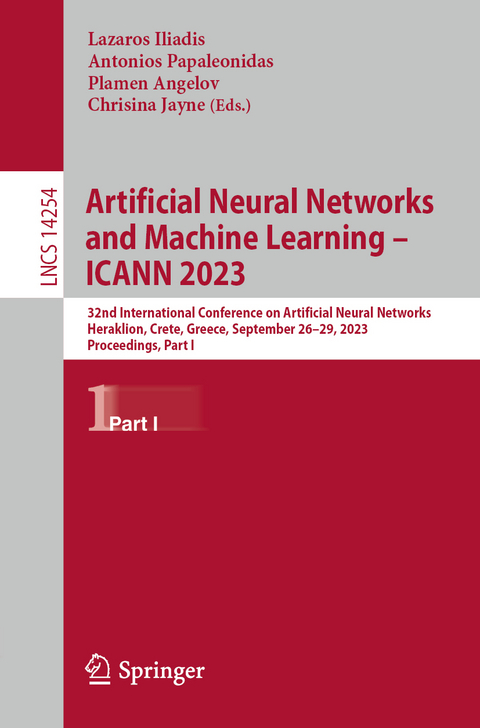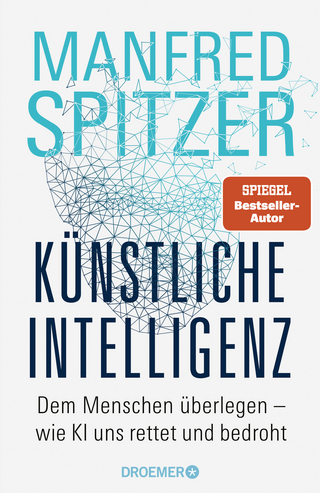
Artificial Neural Networks and Machine Learning – ICANN 2023
Springer International Publishing (Verlag)
978-3-031-44206-3 (ISBN)
The 10-volume set LNCS 14254-14263 constitutes the proceedings of the 32nd International Conference on Artificial Neural Networks and Machine Learning, ICANN 2023, which took place in Heraklion, Crete, Greece, during September 26-29, 2023.
The 426 full papers, 9 short papers and 9 abstract papers included in these proceedings were carefully reviewed and selected from 947 submissions. ICANN is a dual-track conference, featuring tracks in brain inspired computing on the one hand, and machine learning on the other, with strong cross-disciplinary interactions and applications.
A classification performance evaluation measure considering data separability.- A Cross-Modal View to Utilize Label Semantics for Enhancing Student Network in Multi-Label Classification.- A Hybrid Model Based on Samples Difficulty for Imbalanced Data Classification.- A New Dataset for Hair Follicle Recognition and Classification in Robot-Aided Hair Transplantation.- A Policy for Early Sequence Classification.- A Study of Data-driven Methods for Adaptive Forecasting of COVID-19 Cases.- An Ensemble Scheme Based on the Optimization of TOPSIS and AdaBoost for In-class Teaching Quality Evaluation.- Architecturing Binarized Neural Networks for Traffic Sign Recognition.- Boosting Few-Shot Classification with Lie Group Contrastive Learning.- Context Enhancement Methodology for action recognition in still images.- Discrete Denoising Diffusion Approach to Integer Factorization.- Distinguishing the correctness of knowledge makes knowledge transfer better.- Diversified Contrastive Learning For Few-Shot Classification.- Enhancing Cross-lingual Few-shot Named Entity Recognition by Prompt-guiding.- FAIR: A Causal Framework for Accurately Inferring Judgments Reversals.- FeatEMD: Better Patch Sampling and Distance Metric for Few-Shot Image Classification.- FFTRL: A Sparse Online Kernel Classification Algorithm for Large Scale Data.- Fusing Hand and Body Skeletons for Human Action Recognition in Assembly.- Gaze Behavior Patterns for Early Drowsiness Detection.- GH-QFL: Enhancing Industrial Defect Detection through Hard Example Mining.- HaarStyle:Revision Style Transfer Based on Multiple Resolutions.- Semi-Supervised Learning Classifier for Misinformation Related to Earthquakes Prediction on Social Media.- SkinDistilViT: Lightweight Vision Transformer for Skin Lesion Classification.- Sparse Block DETR: Precise and Speedy End-to-End Detector for PCB Defect Detection.- SWP:A Sliding Window Prompt for Emotion Recognition in Conversation.- VDCNet: A Vulnerability Detection and Classification System in Cross-Project Scenarios.- CFNet: Point Cloud Upsampling via Cascaded Feedback Network.- DA-TSD: Double Attention Two-Stage 3D Object Detector from Point Clouds.- Enhanced Point Cloud Interpretation via Style Fusion and Contrastive Learning in Advanced 3D Data Analysis.- PoinLin-Net: Point Cloud Completion Network Based on Geometric Feature Extraction and Linformer Structure.- Accurate detection of spiking motifs in multi-unit raster plots.- Context-dependent computations in spiking neural networks with apical modulation.- QMTS: Fixed-point quantization for multiple-timescale spiking neural networks.- Self-Organizing Temporally Coded Representation Learning.- A System-Level Brain Model for Enactive Haptic Perception in a Humanoid Robot.- Clarifying the Half Full or Half Empty Question: Multimodal Container Classification.- CycleIK: Neuro-inspired Inverse Kinematics.- Robot at the mirror: learning to imitate via associating self-supervised models.- Approximation of Binary-Valued Functions by Networks of Finite VC Dimension.- Color-Dependent Prediction Stability of Popular CNN Image Classification Architectures.- Improving Neural Network Verification Efficiency through Perturbation Refinement.- Relative intrinsic dimensionality is intrinsic to learning.- The Boundaries of Verifiable Accuracy, Robustness, and Generalisation in Deep Learning.- Componentwise Adversarial Attacks.- Decorelated Weight Initialization by Backpropagation.- Exploring individuality in human EEG using reservoir computing.- Learning efficient backprojections across cortical hierarchies in real time.- Neural self-organization for muscle-driven robots.- Novel Synthetic Data Tool for Data-Driven Cardboard Box Localization.- Reinforcement Learningwith Memory based Automatic Chunking for Complex Skill Acquisition.- Retinotopy improves the categorisation and localisation of visual objects in CNNs.- Safe Reinforcement Learning in a Simulated Robotic Arm.
| Erscheinungsdatum | 23.09.2023 |
|---|---|
| Reihe/Serie | Lecture Notes in Computer Science |
| Zusatzinfo | XXXV, 593 p. 196 illus., 172 illus. in color. |
| Verlagsort | Cham |
| Sprache | englisch |
| Maße | 155 x 235 mm |
| Gewicht | 955 g |
| Themenwelt | Informatik ► Theorie / Studium ► Künstliche Intelligenz / Robotik |
| Schlagworte | Adversarial Neural Networks • artificial neural networks (NN) • Bioinformatics • convolutional neural networks • cybersecurity • Deep learning • federated learning • graph clustering • graph neural networks • image-video analysis • machine learning • natural language • Object detection • Optimization • Recurrent Neural Networks • spiking neural networks • Text Mining • Timeseries |
| ISBN-10 | 3-031-44206-7 / 3031442067 |
| ISBN-13 | 978-3-031-44206-3 / 9783031442063 |
| Zustand | Neuware |
| Haben Sie eine Frage zum Produkt? |
aus dem Bereich


